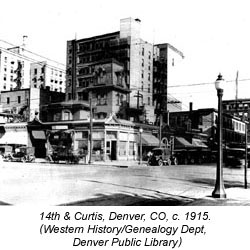Telecommunications History Group Resources
931 14th St. Historic Building
The Site as Skid Row - Building Site History
 The mid-1880s could be seen as a turning point for the area around 14th and Curtis—a turning point in a very downward direction. Two important developments in the Denver urban scene were responsible for this.
The mid-1880s could be seen as a turning point for the area around 14th and Curtis—a turning point in a very downward direction. Two important developments in the Denver urban scene were responsible for this.
First, the development and popularity of street cars—trams running on tracks, acting as the first widely available urban mass transit system—allowed the wealthier residents the option of moving away from the city center to nicer, newer homes. They could still work in the bustling central business district, but could remove themselves to a quieter area at night.
Simultaneously, the central business district itself was moving. New offices and financial buildings were built “uptown” (north and northeast) from the original Denver central area, and it became much more fashionable to have an address in the new area rather than the old—especially as the old area was becoming dominated by factories and much more industrial sorts of businesses.
This combination of the movements of people and businesses left the old “pioneer” neighborhoods available to factory workers and poor immigrants. These neighborhoods were cheap to live in, and some of the old homes and shops were turned into boarding houses. The area became a skid row by the early 1900s.
By the 1920s, however, a few small businesses had begun to move into the area, and the Moffat (or Chenovitch) residence was surrounded by small one-story shops—a shoe repair shop, a laundry, a bookstore, and even a taxidermist’s. It isn’t known for certain whether anyone still lived in the house or had moved on with the other more-moneyed residents; rumors are the mansion had become a boarding house for all sorts of low-life characters. It is known, however, that the area ran down so far that the police put steel cages on some of the street corners (20th and Larimer being one of them) in which they could hold drunkards and criminals until the paddy wagon came to pick them up and take them to jail (see Leonard/Noel book, below).
By the mid-1920s, the area was becoming a business district, which may have made it an attractive site for the Mountain States Telephone and Telegraph Company’s new building. It was still near enough to the center of Denver to serve as the central office, and the land was probably inexpensive enough to make it even more attractive. Not that any expense would be spared on the building itself, though, so perhaps money was no object in the phone company’s decision to make 14th and Curtis rise again—and rise, and rise, over 236 feet, higher than any other building in Denver at the time.
More Building Site Resources:
- Denver: Mining Camp to Metropolis by Stephen J. Leonard & Thomas J. Noel (1990)
- Tom Noel’s history of Denver on the Denver city government
- Western History / Genealogy Department Denver Public Library
- Colorado Historical Society and www.city-data.com/us-cities/The-West/Denver-History.html
